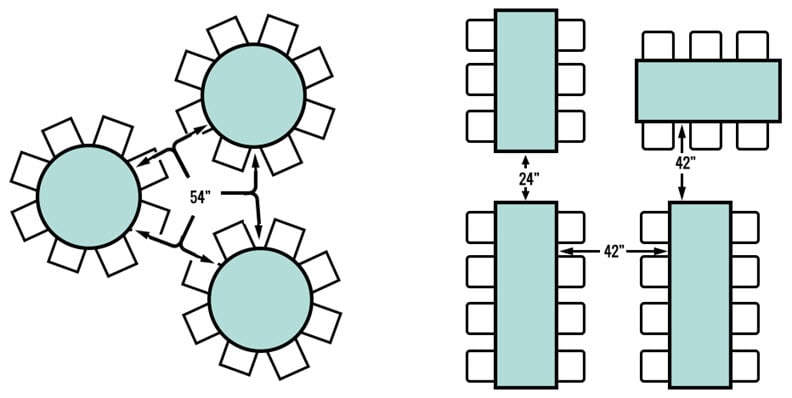In the hospitality industry there always seems to be a battle between restaurateurs need to maximize profit vs. customer's personal space requirements and what they see as a comfortable space to dine in.
Restaurant Tables Spacing

Restaurateurs Needs vs. Customers Preferences
A study done by Cornell University found that what customers see as adequate space differs from what restaurateurs see as such. A well-known fact is that tightly spaced restaurant tables reduce the amount of time customers spend in the restaurant without reducing the spending, thus increasing that day’s turnover rate. However, certain customers will refrain from returning to the restaurant in the future because of the tightly spaced tables.
The study then asked 1,000 Americans about their preferences for table spacing and on its effect on future behaviors. This spacing is something that many restaurateurs “play” with in order to maximize seating capacity without always realizing that it has potential to deter patrons from returning to their venue.
What many restaurant owners fail to consider is that their patrons are often looking for more than just food. What they are after is an entire dining experience and that includes not only a good meal but also a pleasant atmosphere in which people are able to talk and spend some quality time with friends, family or business associates. That means that some privacy is expected and in order for that to happen, adequate space between tables is required (as shown in the image below).

The question is, what does adequate space mean? The answer actually varies depending on the type of dining experience people are looking for and even between different cultural backgrounds. That’s why it’s essential for restaurant owners to understand their customer base and design their restaurant floor plan and layout accordingly. For example:
- When on a date, people expect more personal space and prefer not to be overheard or overcrowded by other diners. The same goes for business meetings.
- Less space is required for lunch breaks or family outings.
- Teenagers accustomed to fast food settings are generally more comfortable with closer table spacing.
- Frequent diners are more comfortable with tightly placed tables compared to those who eat out less often.
- Overall, banquette seating with parallel tables was less desirable, especially for couples, though this layout seems to have less impact on people dining during office lunch breaks.
The current restaurant design modules place tables, on average, 12” or less apart. This setup, though often preferred by restaurant owners, is less desirable to patrons. A possible middle ground between these competing needs is to allow for small restaurant furniture and layout adjustments “on the fly.” For example, if a restaurant is popular with office workers at lunchtime but wants to attract evening patrons, it could slightly change table spacing after the lunch rush and before dinner service. By removing a few tables to increase spacing, evening patrons will feel more comfortable and are more likely to return. This approach, though slightly reducing evening capacity, can lead to more repeat customers and less spending on advertising. The restaurant may also receive more favorable reviews (assuming high food and service standards are maintained).
Diagrams 1 and 2 show the difference between acceptable table spacing during lunch (Diagram 1) and evening (Diagram 2) hours:


Diagram 1 Diagram 2
In summary, a fast food or take-out restaurant, where seating isn’t as critical, will likely do fine keeping a layout of tightly spaced tables. However, the study mentioned above has relevant and important implications for restaurant managers and owners with long-term visions of success and a diverse customer base. Being able to easily and quickly adjust table spacing throughout the day is an important factor in the long-term success of venues catering to various types of patrons.

